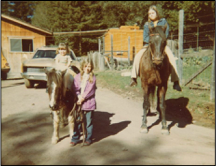Through time, there are similar reasons why people immigrated to the Redwood Coast, choosing to call it home: natural beauty and natural resources. From experience, I can attest this is not an easy place to live because it is rural, remote. In the new millennium the town’s residents have cable internet and cell phone service is unreliable. But the land provides a good life for those willing to work hard and reside in relative isolation from the outside world, a trait that continues to define the character of Comptche residents.
In her 1931 book The Comptche Fire, resident Charlotte Layton described the place in the voice of her time and yet timeless:
“Comptche section [is] so well known for its beauty, and which enjoys a greater reputation for its health-giving climate. It was in search of that precious treasure, health, that I came to Comptche November 20th, 1925 and during that time nature has added appreciably to the ninety-six pounds that I weighed… The yard about my house had been sown to red clover which was now making that rich soft stand so attractive and so useful about a country door yard. A few fine young redwoods standing with their feet in this green mat only added to its beauty.”
Writing about Comptche life in the 1970s, Flora, a research participant who was a back-to-the-land newcomer, wrote a description similar to Charlotte’s of 1931:
“It’s secluded location and expansive wilderness provide an Eden-like beauty. The forest filled with healing herbs, magnificent wild flowers and wild animals is enchanting.”
A quintessential Comptche way of life has persisted through time, showing how land has evolved along with people. The community has intentionally kept growth at bay—there are no services for tourists, not even a rest room at the Comptche Store. The beauty and benefits noted by Charlotte Layton in 1931 harmonize with reasons attracting newcomers in the Seventies: beauty of place, health, safety, ideal setting for raising children.
Amidst the rapid pace of change it takes planning, relationships, and cooperation for a community to preserve a way of life and become stewards of the local environment.
The boom and bust nature of the timber industry has had a corresponding boom and bust effect on the region’s population. An awareness among timber industry leaders of their responsibility for natural resources is evident in the early 1900s, when E.C. Williams, who owned Mendocino Lumber Company from 1872-1906, lamented what he calls a desecration of a primordial place:
“The winter rains had not wholly ceased and the river bank full… the tall redwoods with their great symmetrical trunks traveling toward the skies, with the bright colors of the rhododendrons profusely scattered over the hills. Over all the hush and solitude of the primeval forest… as I recall the beauty of this picture, I cannot but regret the part it appeared necessary for me to enact in what now looks like a desecration.”
Patterns of resource depletion and recovery follow immigration patterns to the Redwood Coast. The sea otter population, nearly lost to the Russian fur trade in the early 1800s, has recovered under protected status.
Throughout the 1800s, pioneers found opportunity and riches in timber and fisheries, and Mendocino county’s population grew along with the world wide demand for forest products. A logging boom after WWI attracted Italian and Portuguese timber workers who had first immigrated to the Midwest and southeastern U.S. This logging boom depleted resources faster than Nature could regrow them, leading to mill closures and job loss in the 1960s. Many people left, creating room for the next wave of in-migration in the 1970s: the back-to-the-land movement.
Up Next: Chapter 4: Comptche in the 1970s: Land, Children, Fire
References for this post:
Layton, Charlotte, 1931. The Comptche Fire.
Mendocino Redwood Company, 2012. History of the Land. Electronic document, accessed 3/18/2021. www.mrc.com/history.








